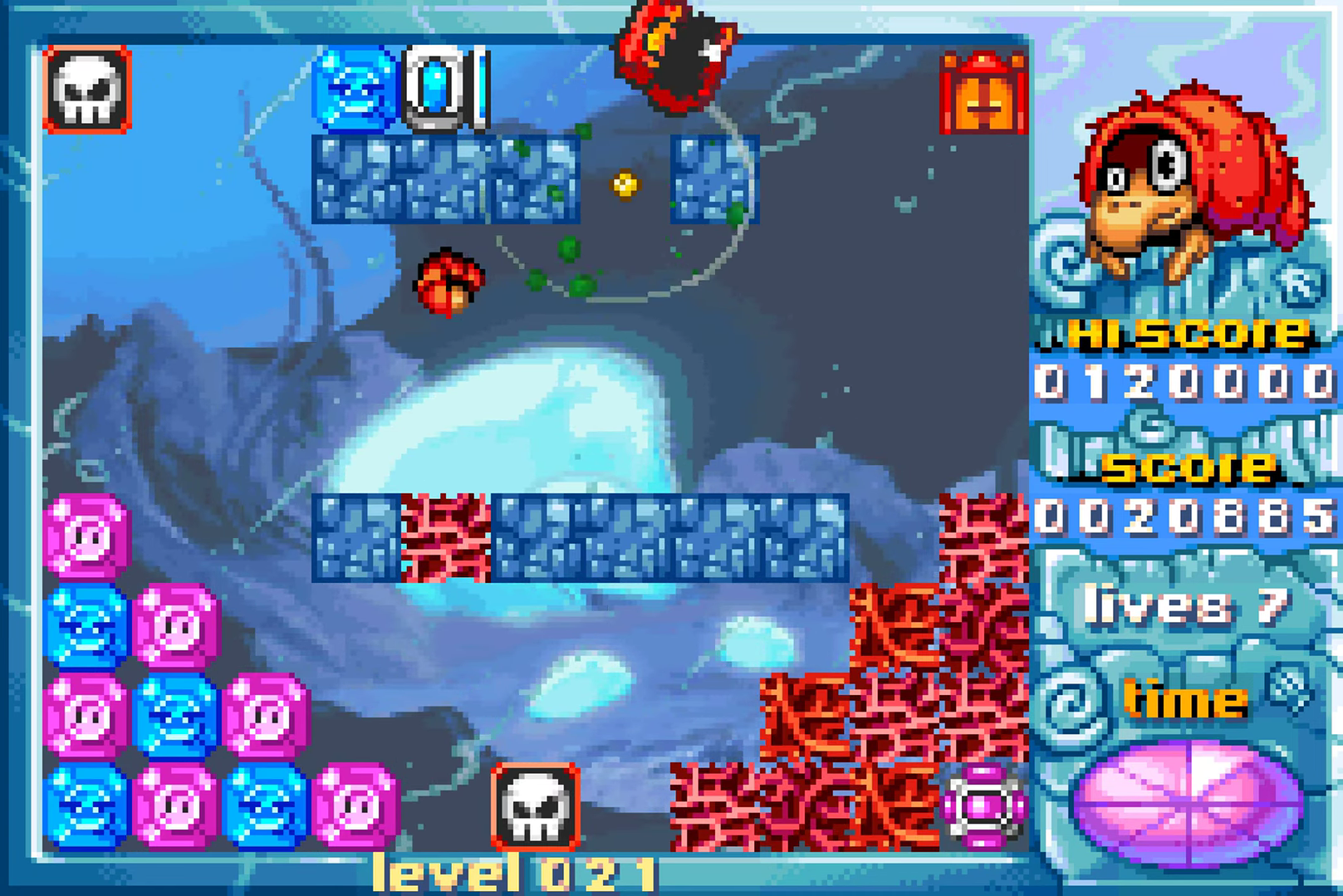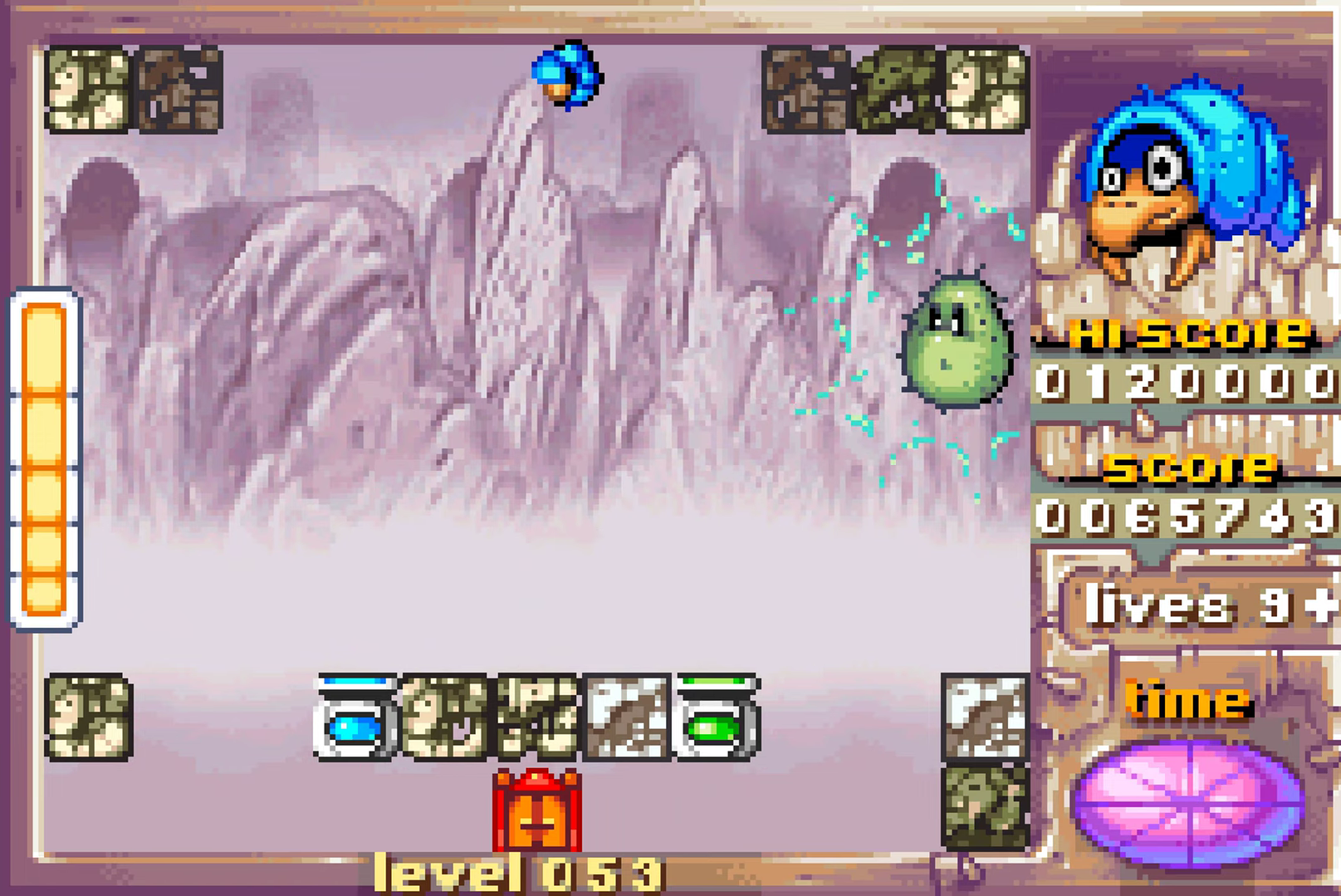Gem Smashers - BreakOut Hit
09/06/25

Generally when I pick up a game I’ve never played - let alone seen - before for the Game Boy Abyss, I very rarely do a lot of research as to what the game is beyond the very basics. As such, and this can be a bad thing, assumptions can rule the day in these cases. I do my best to avoid hating platformers, I really do, but when I see a low-budget licensed platformer, oh, my stomach drops. But in any case, when I picked up Gem Smashers, from the handful of screenshots I glanced at, I expected something like the orb-clearing puzzler Puzzle Bobble, but instead, Gem Smashers feels like some sort of wondrously addictive mix between pinball and BreakOut. Whilst undoubtedly a bit simplistic, it’s arcadey-nature and general wealth of content for a game of this scale makes it perfect for a pick up and play console like the Game Boy Advance.
Gem Smashers is one of those really weird games that I’ve genuinely never heard someone else talk about, but it seemingly did well enough to earn a remake over a decade later for the PlayStation 4 era of consoles that is apparently far, far worse then the relaxing, snappy puzzler we’re taking a look at today. That, on it’s own, is a fun little fact for Gem Smashers, but what’s even more bizarre is that this game, albeit by it’s own devs, got a goddamn pallate swap follow up in the form of M&M’s Break ‘Em. I’ll attest, in the couple of hours I spent in Gem Smashers, as delightful as it was, I never felt that what this game was missing was the presence of some anthropomorphised candy, but hey, I’m just a weirdo writing about Game Boy Advance games, I don’t know what people want.

Regardless of its candy-based content, Gem Smashers' gameplay is pretty straight forward. Your chosen character - one of three, each of which will have different speeds and whatnot, but otherwise function identically - will automatically bounce upwards and downwards between solid surfaces, with you having some control of your lateral direction. Each level consists of a field that’ll be populated by various blocks, which can take the form of coloured gems, skull-faced death squares, or ‘plain’ blocks, breakable and unbreakable alike. The goal of the majority of levels is to clear all of the coloured gems from the field and enter the door that will lead to the next stage; you can clear a block by bouncing into it with your character, similarly to something like BreakOut, but the caveat is that your character must be the same colour as the gem block you’re attempting to clear. Scattered around each stage, sometimes hidden beneath a breakable block, are devices that upon impact will change you to their designated colour. So basically, the loop of each level will be you bouncing too and fro, strategically changing your colour to break all the blocks on each level whilst deftly avoiding the skull-faced death squares that’ll end your life in a single touch. It’s a decently simplistic game that’ll only take a few minutes to get the hang of, but it’s a very satisfying, arcadey experience that feels like a refined equivalent of an OG Game Boy game. It just works and scratches my brain in that perfect little way.
Breaking gem blocks and ‘plain’ blocks alike can sometimes produce items from within; whilst frequently you’ll have to break a certain block to gain access to the exit door, but it’s worth breaking gems and normal blocks alike as you can get a huge selection of bonus items just as you’re normally completing the level. Whilst these are usually beneficial, occasionally these bonus items will spell doom for your little guy, like reversing your controls or just outright killing you, there and then. Whilst pretty much all the bonuses are a fun addition, the randomness of how they appear feels a bit odd to me. Sometimes you’ll just get an item that’ll give you almost no points - sometimes, you’ll get an item that’ll break all gems the same colour as you. But sometimes, you’ll break a gem to reveal a purple door that functions just like a secret entrance to the board, skipping the rest of it instantly. Each power up isn’t unwelcome, but the fact that I can just randomly find an item that’ll complete the level for me feels… weird? Almost like I’m cheating. And whilst the death items do give you a little more to play around, it can be very easy to pop a ton of squares and just run into a death item without even realising, which happened a handful of times in my time with Gem Smashers.

Overall, it’s a very snappy, to-the-point physics puzzler that really surprised me with it’s quality. I very quickly fell into the rhythm of scanning each board, identifying where everything I need is or my optimal path through the stage. The Game Boy Advance is capable of a lot of really beautiful, quality titles that rival the best outputs of that time in gaming - games like Mother 3, Mario and Luigi, Wario Land or Golden Sun that are all 9-10/10, Game of the Year candidates, but there is nothing wrong with an extremely solid, easily accessible 7/10 puzzler. It won’t change your life, but it’ll make the next few hours - or the odd hour here and there beyond - very lovely.
It’s the kind of simplistic gameplay where I find it very hard to nitpick any real issues with it. I can’t even complain that it’s a bit simplistic, since it overall has a pretty decent pace and you’re in and out of a level within a minute or two. If I was really reaching I’d say that sometimes I found deaths more than a little unfair - I’d seemingly barely *graze* a skull block, close enough that I couldn’t even tell that I touched it, and there goes a life. Lives can be earned by hitting certain milestones of points in both modes, but with how brutal sudden deaths can be, it’s pretty upsetting to see your gains evaporate in a single moment. Plus, in story mode, occasionally you’ll break blocks and get a power-up that is, in fact, literally a potion of death with almost no space to navigate around it and bang, another death. I can put up with slightly unfair deaths in Story Mode, since you can just save after every set of maps, but the occasionally odd hitboxes of the skull blocks in Arcade Mode can be brutal. But what are, in fact, Arcade and Story mode?
The game features two major modes to tackle for the average player; Arcade, and Story. Arcade is pretty straight forward - you’re presented with a gauntlet of boards to clear to try and reach the end. The key mix-up it has is after a handful of stages, you’ll have the option to pick two paths of boards. Struggling with a particular set of boards? Pick the other one on your next run. In addition to earning points from just clearing gems, Arcade also provides you with tons of pickups that’ll award large amounts of points after collecting a certain amount of each. Arcade is certainly more of a marathon then a sprint, and with how easy it is to die after just happening to bounce in the wrong direction, it can be a little frustrating to get pretty far in this mode and then spin out from just some unlucky deaths. Still, the balance of the difficulty is tuned well enough that I consistently felt the need to give Arcade Mode one more try to push through. In the scope of this review, I didn’t quite reach the end, but the fact I didn’t just give it up after one or two runs just so I can write about it for the review speaks volumes about how solid it is overall.

Story Mode, rather than giving you a linear series of boards like Arcade Mode, drops you into an overworld divided into a number of mini-zones, each of which consists of a number of nodes that, in turn, consist of a number of boards you have to complete in sequence. Story mode, honestly, isn’t *that* different to Arcade mode, except for the fact there are a smattering of cutscenes here and now and that there’s a certain amount of non-linearity in that you can traverse the map and pick what sets of boards you want to play in what order. Beyond the node-based map and completing a sequence of maps, it is essentially the same game as Arcade, just in a different format and the ability to save between each level, which makes the occasional BS death a little more palatable. They probably could’ve changed some things up a little bit more, but with the core gameplay loop being as solid as they are, I didn’t really mind.
The other major difference the game’s story mode also features is a handful of boss encounters, usually at the end of a gauntlet of run of the mill stages. These are inherently, due to your character's limited skillset, essentially the same as the normal stages, as each boss will have a glowing part of their body that corresponds to one of the colours you can switch to. Slam into them, avoid a few sequences of attacks (which usually just results in them menacingly moving back and forth), wash, rinse, repeat. They’re fine, they’re not nearly as interesting as the core block-smashing stages, but they’re certainly not bad as a palate cleanser, especially with how quick they are. Much like Arcade Mode, my time with Gem Smashers was a bit limited, so I didn’t quite hit the end of the Story Mode, but Gem Smashers falls into the limited group of GBA games that’ll I’ll absolutely pick up now and again for the path of mastery. The fact the game is easy on the eyes doesn’t hurt that replayability, either. It’s definitely a bit limited in the audio-visual department, with only a handful of songs and general aesthetics to its various levels, but each one has enough soothing tunes and genuinely attractive designs to add, rather than take, from the puzzling experience.

Gem Smashers, in some ways, feels like the perfect game for the GBA, especially when you’re looking for something more arcadey and pick up and play. Sure, after a few hours you’ll have exhausted all of the unique content the game has to offer, but the action is fast enough to keep you engaged, especially if you’re the kind to hunt for high scores. I’m not, personally, but I enjoyed my time with the game enough that I could imagine the more arcade-tainted among us would feel the pull far more strongly. It also feels fairly unique in the GBA space; all manner of arcade games, some original, some shameless copies, popped up on the system, and whilst many of them you can kind of trace their origin, Gem Smashers, beyond a first glance, really stands out on its own.
But maybe it really *is* missing a bit of candy here and there…
Thanks for reading my review of Gem Smashers. I love playing a game that genuinely surprises me. Had a great time with this one, just gotta hope that M&M follow-up can match that satisfying mark. What? I gotta be optimistic sometimes. In any case, the next review will be the big 90 - I can’t believe we’re nearing the hundred mark. As always, you can email me at mgeorge7003@hotmail.com if you have any questions or requests, or find me over on Twitch or Bluesky @GameBoyAbyss. Thanks again, and I’ll see you in my next review.
